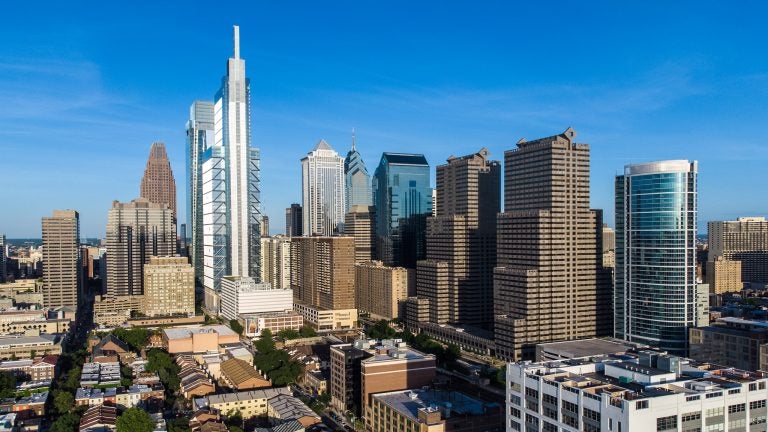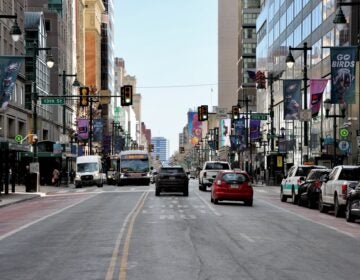Philly set a new record for construction in 2019 — thanks to these gentrifying neighborhoods
Philadelphia saw a record-setting year for construction in 2019, capping off a decade-long period of growth for the city’s real estate market.

The Comcast Technology Center dominates the Philly skyline. (Mark Henninger/Imagic Digital)
Philadelphia saw a record-setting year for construction in 2019, capping off a decade-long period of growth for the city’s real estate market.
The city’s Department of Licenses and Inspections issued more than 2,100 new construction permits in 2019 for projects of all shapes and sizes. It was the highest total of any year since L&I began digitizing permit records in 2007 and represents a more than a 250% increase over a citywide nadir in building after the 2008 recession.
“In general, Philadelphia remains a vibrant, growing city,” said Joseph Gibson, a researcher at CBRE, a commercial real estate services and investment firm. “Folks are continuing to bet on Philadelphia.”
As in years past, most projects were concentrated in the halo surrounding Center City. The majority of projects were described as single-family housing, as opposed to apartments or commercial construction.
The 19146 ZIP code, which includes portions of the Graduate Hospital and Point Breeze neighborhoods, saw the most intense levels of construction activity in Philadelphia, with more than 300 new construction permits issued over the past year. Fishtown and neighborhoods surrounding Temple University, in North Philadelphia, also recorded hundreds of new permits in 2019.
But other sections of the city, by contrast, saw almost no new construction at all. Large swaths of Southwest Philadelphia and lower Northeast Philadelphia saw just a handful of new projects. East Oak Lane recorded zero new building permits across all of 2019.
Many of the neighborhoods where construction didn’t happen in 2019 are semi-suburban, post-war neighborhoods closer to city limits than downtown — sometimes called “middle neighborhoods.” These same areas also recorded notable jumps in poverty over the past decade, according to the U.S. Census Bureau’s American Community Survey.
Community leaders, like Councilmember Cherelle Parker have frequently sought to highlight a crisis of disinvestment and depopulation in these areas, which still play a key role in housing much of the city’s middle class.
“Nearly half of the city’s population lives in middle neighborhoods,” she said. “These neighborhoods have not only helped stabilize the city’s tax base during periods of decline, but offer a solid, affordable housing stock. Reinvestment in these areas is critical to the city’s continued growth beyond Center City.”
Only Northwest Philadelphia’s leafy neighborhoods seemed to buck this trend, attracting hundreds of new construction projects despite being relatively distant from Center City.
High demand, high prices
The sheer number of permits issued in an area is not always reflective of the full scope of construction activity. In 2019, some outlying neighborhoods saw hundreds of small rowhouses begin to rise while Center City saw just a few new construction projects — but these were often larger, multi-unit projects. Southern Land Company’s $300 million, 60-unit tower, known as “The Laurel,” accounted for one of just 25 new construction permits issued in Center City’s 19103 ZIP code.
But, in general, Gibson said the 2019 construction boom generally reflected the strength of the city’s real estate market. He said there was little evidence of an oversupply of housing units — a real estate bubble — and some evidence that the city continues to suffer from an apartment shortage. While an economic downturn seems like an inevitability, Gibson said there were few indicators a recession would drastically impact Philadelphia’s housing market, in the short-term.
”Philadelphia is uniquely positioned for economic downturns for the same reason we’re not well-positioned for upturns. We have a very diverse, very mature economy here,” he said. “It’s a safer bet than most cities when it comes to a downturn.”
On a neighborhood level, increased rates of construction track with increases in property value and gentrification. The Graduate Hospital neighborhood, for example, has morphed into the city’s wealthiest neighborhood after two decades of above-average construction activity, according to American Community Survey Data released this month.
Affordable housing advocates, like Beth McConnell, policy director at the Philadelphia Association of Community Development Corporations, said the concentration of new development added strain on residents in the nation’s poorest big city.
“While we’re certainly seeing signs of wealth all around us in Philadelphia — in new housing, new restaurants, new stores — we have to keep in mind that the median household income in Philadelphia is under $40,000 a year,” she said. “We need to be thinking about housing stock that serves the residents that are here and that means more affordability.”
McConnell said the city needed to staunch the loss of existing affordable housing, due to expiring income restrictions on low-income rentals or simple decay. She said the city also needed to invest more in the production of low-cost apartments and affordable, for-sale units of housing.
McConnell said some 70,000 renter households here were already paying an “unsustainably high” percent of their incomes on housing costs, a crisis exacerbated by generally rising real estate prices.
“That’s a huge number of people that are waiting and need assistance in finding affordable homes,” she said. “And there are a number of landlords that are raising rents now, just because they can.”
Although the rate of new construction in Philadelphia has increased over recent years, it is worth noting that the pace is far lower than in the city’s distant boom years.
Building reports from 1940 — a time of confluence between New Deal reinvestment programs and development reaching the city’s most outlying areas — recorded more than 6,500 new building permits. In 1925, the city set a record for housing construction with nearly 12,000 single-family dwellings constructed in that single year, according to a Philadelphia Inquirer article from that time.
An office boom in 2020?
Looking ahead to the new year, Gibson expects a one-time surge in construction as developers seek to take advantage of the 10-year tax abatement ahead of its planned reduction.
“I don’t know exactly how that will affect development in the long term. But we might see an uptick in the short term as they try to take advantage of that window while it still exists,” he said.
Philadelphia’s office sector has historically been plagued by high construction costs and low rents. But Gibson also predicted that pent-up demand for office space would finally translate into the construction of new downtown towers.
“The amount of office space hasn’t really changed much in Philadelphia, but vacancy rates have gone down steadily,” Gibson said. “More and more downtown office tenants are looking for high-quality space in amenity-rich buildings. It’s less about cost and more about attraction and retention of their workforce.”
McConnell said that the burgeoning real estate market was a mixed blessing. The city had realized greater tax revenue to fund government services and expected over the next five years to see roughly $100 million pour into the Housing Trust Fund — a pool of affordable housing dollars fueled by real estate fees and taxes.
“Tax revenues are up and so there are more resources to invest in new affordable housing. Obviously, new construction and development is part of that pie,” McConnell said. “But development also creates challenges of affordability in some neighborhoods where residents can’t keep up with rising costs.”
WHYY is your source for fact-based, in-depth journalism and information. As a nonprofit organization, we rely on financial support from readers like you. Please give today.







